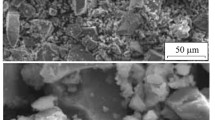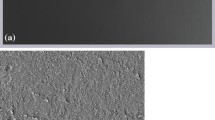Compositions for producing silicon-carbide materials with a nitride binder in which the initial binders were artificial ceramic binders based on silicon and silicon carbide were studied. The influence of the firing regime and binder composition on the main physicomechanical characteristics and microstructure of samples after nitriding firing was studied.
Similar content being viewed by others
Avoid common mistakes on your manuscript.
Silicon-carbide (SiC) composites are used in various technology areas, including ferrous and nonferrous metallurgy, the chemical and ceramic industries, etc. They are especially useful in nonferrous metallurgy for production of Zn, Al, and other metals. SiC refractories are heterogeneous composites in which separate SiC grains are cemented by binders with compositions and physicochemical properties that differ from those of the main phase. SiC materials based on nitride and oxynitride binders with high oxidation resistance at high temperatures are especially interesting [1,2,3].
SiC refractories are prepared from formulations consisting of polydisperse SiC filler, finely disperse Si powder (sometimes finely disperse quartz sand is added), and a temporary technological binder. Prepared items are dried and fired at 1400 – 1500°C in N2 [4, 5]. The technology based on using artificial ceramic binders (ACBs) obtained from special highly concentrated ceramic binder suspensions (HCBSs) is one of many possible methods for producing SiC materials with analogous properties [6, 7]. Highly reactive ultrafine particles that ensure the optimal interfaces between grains form during firing are synthesized during ACB production. An ACB based on SiC and Si that was studied in detail in previous work [8,9,10] was used in present work as the binder for SiC composites.
The first stage included studies of composites consisting of polydisperse SiC filler and a binder based on SiC ACB. The composites were formed via bilateral vibrational compression at 0.1 MPa. This forming method is widely used to produce SiC items for various purposes and typically requires less material and energy. The optimal filler grain composition was selected according to the particle packing coefficient [11] for vibrational compression at 0.1 MPa. It was found that a composition containing 20% of the fraction <0.25 mm; 40%, 0.5 – 2.5 mm, and 40%, >2.5 mm had the maximal packing coefficient of 0.59.
Previous research [9, 12] found that the optimal ACB concentration was 55% if a suspension based on SiC was used as the binder for SiC composites. Samples fired at 1300°C in an oxidizing medium were characterized with the best physicomechanical parameters. Compositions of SiC composites with an analogous binder content and 45% polydisperse filler of the optimal composition were studied. Experimental samples were formed by vibrational compression, dried at 100 – 110°C, and fired in N2 at 1000 – 1400°C with holding at the maximum temperature for 2 h. The main physicomechanical characteristics of the fired samples were determined (Fig. 1). The open porosity (Πop) decreased to 26.5 – 26.8%; apparent density (ρapp), by 1.5 – 2.0%, if the nitriding firing temperature was increased to 1400°C. However, the compression strength (σcom) increased to its maximum value of 24 – 25 MPa. Such low physicomechanical parameters, especially the strength even at the maximum firing temperature, were indicative of insignificant formation of nitrides (1.5 – 2.0%) in the SiC binder. This agreed with previous investigations [10], which found that a combined ACB based on SiC and Si was highly effective and increased the degree of nitriding, thereby enhancing the physicomechanical characteristics of the material.
Therefore, compositions of SiC materials with ACBs based on SiC and Si in various ratios (Table 1) were further studied. Samples were formed, dried, and fired in N2 at 1430°C for 10 h. The N contents in fired samples of various compositions were determined using an energy-dispersive spectrometer (Fig. 2). The N concentration decreased to 11.2% if the SiC ACB content in the binder was increased. The N content was maximal (22.8%) in compositions with Si ACB as the binder and was twice that for composites based on the SiC ACB. This indicated that composites in which silicon nitride and oxynitride were formed were highly nitrided, which was confirmed by x-ray phase analysis.
Figure 3 shows the main physicomechanical characteristics of the SiC composites based on binders with various SiC and Si ACB concentrations. The Πop increased by 10 – 11% from the minimum of 15% to a maximum of 25 – 26% if the content of SiC ACB was increased and that of Si ACB was correspondingly reduced (Fig. 3a ). Thus, ρapp increased insignificantly by 3 – 4% from 2.37 to 2.45 g/cm3 (Fig. 3b ). It is noteworthy that σcom decreased by more than three times from a maximum of 155 MPa to a minimum of 45 MPa as the fraction of SiC ACB in the binder increased (Fig. 3c ). Such unusual changes of the main physicomechanical characteristics, i.e., increased porosity with increased sample density, indicated that the degree of nitriding decreased and a more porous structure formed.
The microstructures of the composites were studied using a TESCAN MIRA3 LMU scanning electron microscope (Fig. 4). Photomicrographs of materials fired in N2 showed that the structure of the material in the intergrain space was characterized by a finely disperse structure with widely developed microfibers of nitrides if the SiC ACB concentration was increased to 13.75% (Fig. 4, compositions 1 and 2 ). The diameters of the nitride microfibers situated in the pore space between large filler particles increased insignificantly if the SiC ACB content was increased to 41.25% with a corresponding decrease of the Si ACB concentration to 13.75% (compositions 3 and 4 ). The number of fibers per unit volume decreased so that Πop of the composite increased while σcom decreased (Figs. 3a and 3c). The material structure enlarged considerably if only SiC ACB was used as the binder (Fig. 4, composition 5 ). Thus, the number of fibers diminished greatly while their diameters increased significantly. This helped to loosen the material structure and decrease slightly σcom of the composite. Reinforcement of the structure increased substantially if nitride microfibers formed in the structure, increasing significantly σcom of the composite and decreasing its Πop.
Thus, the studies found that Si ACB and Si ACB in combination with a slight (up to 15%) content of SiC ACB were the most effective binders for producing SiC composites based on a nitride binder. These binders were shown to produce SiC composites with an ultrafine disperse nitride structure characterized by Πop 15 – 22% and σcom 130 – 155 MPa.
References
I. D. Kashcheev and K. G. Zemlyanoi, Production of Refractories: Study Guide [in Russian], Lan’, St. Petersburg, 2017, 344 pp.
N. T. Andrianov, V. L. Balkevich, A. V. Belyakov, et al., Chemical Technology of Ceramics: Study Guide [in Russian], RIF Stroimaterialy, Moscow, 2012, 496 pp.
I. D. Kashcheev, K. K. Strelov, and P. S. Mamykin, Chemical Technology of Refractories: Study Guide [in Russian], Intermet Inzhiniring, Moscow, 2007, 752 pp.
K. K. Strelov, I. D. Kashcheev, and P. S. Mamykin, Refractory Technology, Metallurgiya, Moscow, 1988, 528 pp.
G. G. Gnesin, Silicon-carbide Materials [in Russian], Metallurgiya, Moscow, 1977, 216 pp.
Yu. E. Pivinskii, Ceramic and Refractory Materials: Collection of Works, Vol. 2 [in Russian], Stroiizdat, St. Petersburg, 2003, 688 pp.
Yu. E. Pivinskii, Rheology of Disperse Systems, HCBS, and Ceramic Concretes. Elements of Nanotechnology in Silicate Materials Science: Collection of Works, Vol. 3 [in Russian], Politekhnika, St. Petersburg, 2012, 682 pp.
V. A. Doroganov and Yu. N. Trepalina, “Highly concentrated ceramic binder suspensions based on silicon carbide,” Refract. Ind. Ceram., 51(4), 302 – 304 (2010).
V. A. Doroganov, E. A. Doroganov, E. I. Evtushenko, et al., “Refractory materials based on artificial ceramic binder suspensions of silicon carbide composition,” Vestn. BGTU im. V. G. Shukhova, No. 4, 156 – 160 (2013).
S. V. Zaitsev, E. A. Doroganov, V. A. Doroganov, et al., “Artificial ceramic binders based on silicon and silicon carbide for silicon-carbide refractories in a nitride matrix,” Nov. Ogneupory, No. 9, 25 – 30 (2019).
V. A. Doroganov and E. I. Evtushenko, Refractory Ceramic Concretes: Monograph [in Russian], LAP Lambert Academic Publishing GmbH & Co. KG, Saarbrucken, 2011, 188 pp.
V. A. Doroganov, N. A. Peretokina, E. A. Doroganov, et al., “Study of nano-differentiated silicon carbide binders and composites based on them,” Refract. Ind. Ceram., 55(5), 465 – 468 (2015).
Acknowledgments
The work was sponsored by the Flagship University Development Program at V. G. Shukov BSTU.
Author information
Authors and Affiliations
Corresponding author
Additional information
Translated from Novye Ogneupory, No. 2, pp. 26 – 29, February, 2020.
Rights and permissions
About this article
Cite this article
Kirillova, N.K., Shakurova, N.V., Doroganov, V.A. et al. Nitride-Bonded Silicon-Carbide Composites Based on Artificial Ceramic Binders. Refract Ind Ceram 61, 82–85 (2020). https://doi.org/10.1007/s11148-020-00434-y
Received:
Published:
Issue Date:
DOI: https://doi.org/10.1007/s11148-020-00434-y








